D:\Documents and Settings\Ana\My Documents\Biserka-knjiga ...
D:\Documents and Settings\Ana\My Documents\Biserka-knjiga ...
D:\Documents and Settings\Ana\My Documents\Biserka-knjiga ...
Create successful ePaper yourself
Turn your PDF publications into a flip-book with our unique Google optimized e-Paper software.
Table 3: The growth of Internet use in Europe <strong>and</strong> in Southeastern Europe*<br />
Population<br />
(2007 est.)<br />
Internet users,<br />
latest data<br />
% population<br />
(penetration of<br />
service)<br />
% of total<br />
number of users<br />
in Europe<br />
User growth<br />
(2000-2007)<br />
Europe** 801 821 187 348 125 847 43.4 % 100% 231.2 %<br />
Albania 3 600 523 471 200 13.1 % 0.1 % 18 748.0 %<br />
Bosnia <strong>and</strong><br />
Herzegovina<br />
Access, piracy <strong>and</strong> culture: the implications of digitalization in Southeastern Europe<br />
4 552 198 950 000 20.9 % 0.3 % 13 471.4 %<br />
Bulgaria 7 322 858 2 200 000 30.0 % 0.6 % 411.6 %<br />
Croatia 4 493 312 1 684 600 37.5 % 0.5 % 742.3 %<br />
Greece 10 706 290 3 800 000 35.5 % 1.1 % 280.0 %<br />
Macedonia 2 055 915 392 671 19.1 % 0.1 % 1 208.9 %<br />
Moldova 4 328 816 727 700 16.8 % 0.2 % 2 810.8 %<br />
Montenegro 684 736 266 000 38.8 % 0.1 % n/a<br />
Romania 22 276 056 7 000 000 31.4 % 2.0 % 775.0 %<br />
Serbia 10 150 265 1 400 000 13.8 % 0.4 % 250.0 %<br />
*The table is based on the data provided by the Inter World Stats (2008).<br />
**Figures for “Europe” include all 52 countries of Europe.<br />
On the other h<strong>and</strong>, although this increase in the number of users is rather high,<br />
looking at the penetration rates, there is still significant room for a further increase.<br />
As can be seen in Table 3, half of the SEE countries still have a penetration of Internet<br />
service of less than 20%, while in other countries it ranges around 30% (the span<br />
being from 13.1% (Albania) to 38.8% (in Montenegro)). This shows that the<br />
European level of connectivity to the Internet has still not been reached in all of the<br />
countries. When looking at the penetration of service, we can see that the use of the<br />
Internet is still limited to a rather narrow stratum of people in SEE countries.<br />
The data presented above provides a general insight into the changing nature of<br />
digitalization in the SEE region. Although the usage of ICT is still low in comparison<br />
to Western EU neighbours, it is growing rapidly. This situation can also be partly<br />
attributed to the transition processes of the states in question where problems with<br />
adjustment <strong>and</strong> implementation of legislature in this field are still present. One should<br />
also mention the SEE region’s poor overall economic position in the last decade (high<br />
unemployment rates, low purchasing power of citizens, etc.) which is an additional<br />
reason for the situation.<br />
77



